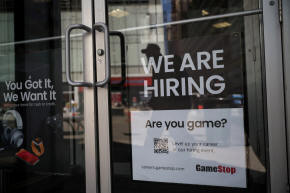Solid U.S. job growth anticipated in May; unemployment rate seen at 3.5%
 Send a link to a friend
Send a link to a friend
[June 03, 2022] By
Lucia Mutikani
WASHINGTON (Reuters) - U.S. employment
likely increased at a brisk clip in May, with the jobless rate expected
to have dropped to its pre-pandemic low of 3.5%, signs of a tight labor
market that could keep the Federal Reserve's foot on the pedal to cool
demand.
The Labor Department's closely watched employment report on Friday, also
expected to show strong wage gains last month, would paint a picture of
an economy that continues to expand, although at a moderate pace.
The Fed is trying to dampen labor demand to tame inflation, without
driving the unemployment rate too high. The U.S. central bank's hawkish
monetary posture and the accompanying tightening of financial conditions
have left investors fearful of a recession next year.
"This report is going to continue to exhibit signs of a tight labor
market and when combined with the elevated inflation environment we are
in, it further gives the Fed the confidence that they need to stay on
their substantial monetary policy tightening path," said Sam Bullard, a
senior economist at Wells Fargo in Charlotte, North Carolina.
Nonfarm payrolls likely increased by 325,000 jobs last month after
rising 428,000 in April, according to a Reuters survey of economists.
That would be the smallest gain in a year, and would end 12 straight
months of payroll gains in excess of 400,000, the longest such streak on
record. Employment would be about 865,000 jobs below its pre-pandemic
level.
Estimates ranged from as low as 250,000 jobs added to as high as
477,000. Job gains, however, would still be way above the monthly
average that prevailed before the COVID-19 pandemic started in 2020.
The survey was conducted before the ADP National Employment Report on
Thursday, which showed private payrolls rose by only 128,000 jobs in
May, the smallest gain in two years. That prompted economists at Goldman
Sachs to lower their nonfarm payrolls forecast by 50,000 to 225,000.
Economists are split on whether the moderation in the pace of job growth
is because of cooling labor demand or worker shortages, and urge
investors to focus on the unemployment rate and wage growth to gauge the
tightness of the jobs market. There were 11.4 million job openings at
the end of April, with nearly two positions for every unemployed person.
"While we agree job growth is moderating, the labor market is still
strong," said Kevin Cummins, chief U.S. economist at NatWest Markets in
Stamford, Connecticut.
[to top of second column] |

A sign for hire is posted on the door of a GameStop in New York
City, U.S., April 29, 2022. REUTERS/Shannon Stapleton/File Photo
The anticipated decline in the unemployment rate from 3.6% in April would push
it back to its lowest level since February 2020, then the lowest since December
1969. A rebound in the labor force participation rate, or the proportion of
working-age Americans who have a job or are looking for one, is anticipated
after it fell from a two-year high in April.
Annual inflation, increasing at rates last seen 40 years ago, and rising wages
are luring some retirees back into the labor force, helping to increase supply.
But the gap between demand and supply remains wide. Average hourly earnings are
forecast rising 0.4% after increasing 0.3% in April.
"It will be some time before a more noticeable rebalancing between labor demand
and supply of available workers," said Veronica Clark, an economist at Citigroup
in New York. "This imbalance suggests further upward pressure on inflation and
the Fed is unlikely to turn more dovish until this key force underlying strong
inflation is resolved."
The U.S. central bank has increased its policy interest rate by 75 basis points
since March. It is expected to hike the overnight rate by half a percentage
point at each of its next meetings this month and in July. Fed Vice Chair Lael
Brainard said on Thursday she saw little case for pausing in September.
Though the cries of a recession are growing louder, most economists believe the
economic expansion will persist through next year. They acknowledged that high
inflation was eroding consumers' purchasing power and business investment, but
argued that the economy's fundamentals were strong and that any downturn would
likely be mild.
The economy's outlook has also been dimmed by a weakening global environment in
part because of Russia's war against Ukraine and China's zero COVID-19 policy.
"There are dark clouds on the horizon. For the next six months, we will be in a
slowdown of economic activity, but I don't necessarily know that we're going
into recession," said Gregory Daco chief economist at EY-Parthenon in New York.
"We should back away from the notion that the next recession is going to be as
severe as the prior one because conditions today are very unique. The prior two
recessions are once in a 100 years type of event. So they're not likely to be
repeated."
(Reporting by Lucia Mutikani; Editing by Andrea Ricci)
[© 2022 Thomson Reuters. All rights
reserved.]This material may not be published,
broadcast, rewritten or redistributed.
Thompson Reuters is solely responsible for this content. |